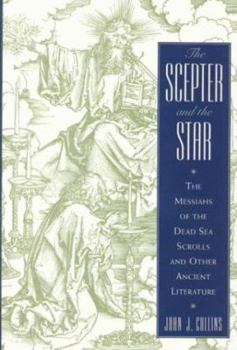The Scepter and the Star
(Part of the Anchor Bible Reference Library Series)
Select Format
Select Condition 
Book Overview
John J. Collins here offers an up-to-date review of Jewish messianic expectations around the time of Jesus, in light of the Dead Sea Scrolls. He breaks these expectations down into categories:... This description may be from another edition of this product.
Format:Hardcover
Language:English
ISBN:0385474571
ISBN13:9780385474573
Release Date:March 1995
Publisher:Anchor Bible
Length:270 Pages
Weight:1.21 lbs.
Dimensions:1.0" x 6.5" x 9.6"
Customer Reviews
3 ratings
Second Temple Messianism
Published by Thriftbooks.com User , 20 years ago
This is a well researched, scholarly book that examines the messianic movements of the second temple period. It basically examines the various phrases (e.g. son of man) associated with the messiah(s) that were expected throughout this period. It certainly was written from a research standpoint to be used for research and not intented as a casual reading. This book gives a fair review of the various expectations such as a warrior type messiah, a suffering servant, as well as some lesser known movements such as the two messiah movement and even the Christianized returning messiah dogma. For the most part, the author is not identifying the messiah as any particular individual, but is trying to provide a broad scope look at the many movements and possible reasons as to how they developed and evolved from one type to another. Drawing heavily upon the Dead Sea Scrolls, the author examines the various Bible texts that imply messianism and attempts to place these messiahs in their proper context. I believe that any serious student of this period would do well to have a copy of this book handy as it should prove to be a well used and well cited text as the research and debate about messianism thrives and grows.
an in-depth study of a complex problem
Published by Thriftbooks.com User , 24 years ago
The Scepter and the Star by John Joseph Collins is an in-depth study of the complex problem of messianism and the varied messianic expectation(s) and speculation(s) during the time of Second Temple Judaism. The subtitle of the book, "The Messiahs of the Dead Sea Scrolls and Other Ancient Literature" is important because Collins does not restrict his study to the Dead Sea Scrolls. He goes through the Pseudepigrapha (a large, open-ended collection of biblically-related and biblically-dependant literature that is not a part of the Bible), the Apocrypha, the Hebrew Bible/Tanak/Old Testament and the messianic ideas contained within those works. Collins also deals with Jesus and the New Testament in this work, although it is on the side that these discussions take place.Collins' knowledge of the Hebrew Bible is extensive on both theological and historical levels. His knowledge is also useful because in the Hebrew Bible are the roots of the problems with messianic interpretation - the scriptures themselves. Once Collins places particular scriptures in their historical context, he then goes on to show their influence(s) and interpretation(s) in various post- and extra-biblical works of literature. We find a pre-existent, heavenly messiah, a priestly messiah, a kingly messiah, and a militant messiah in the works Collins analyzes. At least one messiah was expected and possibly and two, depending on who wrote the work. Collins also deals with the history of the word "messiah" and its various uses in the Hebrew Bible.In reading the book, the reader will gain some insights as to how and why the writers of the New Testament understood Jesus the way that they did, but the goal of the book is not to connect these works to Jesus. The book is, in many ways, a survey of the messianic thought during and before Jesus' time.This book is not an introduction by any means. It is an in-depth study; some previous knowledge of the Scrolls, the Pseudepigrapha, and Second Temple history will be useful to the reader. A glossary would have been nice and helpful and would have opened the doors for less knowledgeable readers to read and understand the book. Overall, this is an excellect read. However, previous knowledge will enable - and perhaps even be necessary - for reader to grasp the many insights in Collins' work.
Excellent Book!!!
Published by Thriftbooks.com User , 24 years ago
The Scepter and the Star is an excellent and indepth study of the controversy between Judaism and Christianity. In this book we find substantial support for the reasons that many Jews did not accept Jesus as their Messiah. The Jews were looking for two Messiahs- not one. There is scriptural support, which is well documented by John Collins that points to two Messiah figures of the Apocalypse. Collins also references Dead Sea Scroll material that specifically points out two figures- a Davidic and a Priestly Messiah . This book explains how two diverse religions came and stayed- Judaism and Christianity- over these differences. It shows how the Bible was more than a religious book, but a history book as well. This is an excellent, well written book that should get people to look again at the Bible and perhaps read it with insight instead of letting others TELL you what it says!!






